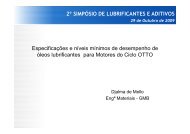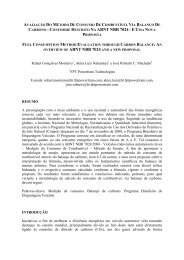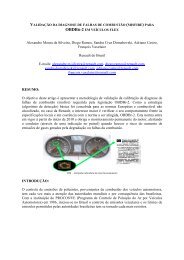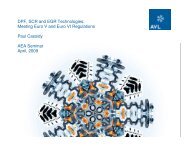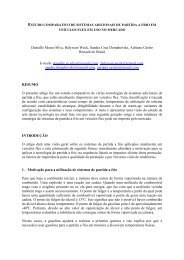Orlando Volpato, Delphi - AEA – Associação Brasileira de ...
Orlando Volpato, Delphi - AEA – Associação Brasileira de ...
Orlando Volpato, Delphi - AEA – Associação Brasileira de ...
Create successful ePaper yourself
Turn your PDF publications into a flip-book with our unique Google optimized e-Paper software.
DIESEL-ETHANOL TECHNOLOGY<br />
<strong>Orlando</strong> <strong>Volpato</strong> Filho e Vicente Pimenta<br />
<strong>Delphi</strong> - Powertrain - Brazil<br />
Abstract<br />
World wi<strong>de</strong> research on alternative fuels has been intensified due to environmental<br />
concern and diminishing of conventional fossil fuels reserves. In Brazil, the usage of<br />
fossil fuel for the production of sugar-cane has been improved over the years, but<br />
there still room for improvements. In the agricultural area, for instance, It is estimated<br />
that for 1 Ton of processed sugar-cane about 2 liters of diesel fuel is used. Over the<br />
last year, a fleet of around 110,000 agricultural machines and trucks burned about<br />
1.2 billion liters of diesel. Along with the opportunity of reducing the emission of green<br />
house gases there is also an economic advantage of using ethanol because the final<br />
fuel cost to the producer is about half the price of the diesel fuel. The reasons above<br />
motivated us to <strong>de</strong>velop a Diesel-Ethanol control for Diesel engines using a<br />
mechanical diesel injection pumps. An add-on system was <strong>de</strong>veloped using an ECM<br />
used for passenger vehicles to control engines with either 4 or 6 cylin<strong>de</strong>rs. In this<br />
system, Ethanol is injected into the intake air stream and a pilot injection of diesel is<br />
used to achieve ignition. This system was <strong>de</strong>rived from a Diesel-CNG system<br />
previously <strong>de</strong>veloped for urban busses. Careful <strong>de</strong>sign of the control algorithms is<br />
required to prevent excessive diesel fuel usage and high hydrocarbon emissions.<br />
This paper will <strong>de</strong>scribe the Diesel-Ethanol system in <strong>de</strong>tail and present some<br />
performance data.<br />
Application<br />
The Diesel-Ethanol technology is better applicable to retrofit of diesel engine controls<br />
with <strong>Delphi</strong> EMS where the availability of low cost ethanol, mainly in ethanol<br />
production plants, makes the operation economically attractive.<br />
Goal<br />
The goal for the Diesel-Ethanol technology is to reduce the usage of fossil based<br />
fuels (diesel) on transportation and agricultural operations. This will reduce the<br />
amount of emitted green house gases. On top of this there are economical gains from<br />
the reduced cost with fuel and possible gains with Carbon Tra<strong>de</strong> due to Clean<br />
Development Mo<strong>de</strong>l projects un<strong>de</strong>r the Kyoto Protocol, this gain could be further<br />
invested on the <strong>de</strong>velopment of clean automotive technologies.<br />
1. Development<br />
In the quest for diminishing its <strong>de</strong>pen<strong>de</strong>nce on foreign petrol along with the need to<br />
reduce emissions of green house gases to improve air quality, Brazil is pursuing the<br />
greater use of alternative fuels.<br />
Page 1 of 18
Diesel-Ethanol vehicles emit lower levels of toxics and ozone-forming hydrocarbons,<br />
mainly because ethanol emits 8.5 times less CO2 than diesel for the same amount of<br />
energy [24].<br />
In Brazil, there is a big <strong>de</strong>mand for diesel fuel. Looking at data taken form the 2008<br />
edition of the Mines and Energy Ministry’s National Energy Accounting (BEN 2008)<br />
[1] one can see from figures 1 and 2, that 41% of the petrol processed goes to diesel<br />
fuel production; 75% of diesel used goes to road transportation and 16% to<br />
agricultural use.<br />
Consi<strong>de</strong>ring the energy used for transportation, the vast majority goes to road<br />
transportation 91.8%, railroad transportation accounts for 4.8% of the used energy.<br />
Consi<strong>de</strong>ring road transportation alone, 51.6% of the energy comes from diesel fuel<br />
and about 19.4% comes from a renewable source (ethanol).<br />
The strong <strong>de</strong>pen<strong>de</strong>nce on diesel fuel leads to some interesting import/export<br />
characteristics. Table 1, below, summarizes the import/export volumes and values for<br />
2008.<br />
It is said that Brazil is self-sufficient in petrol. Most of Brazilian’s petrol is of heavy<br />
type, not suited for diesel production, in or<strong>de</strong>r to attend the <strong>de</strong>mand for diesel fuel<br />
light petrol and diesel fuel is imported. We have excess heavy petrol and gasoline,<br />
which are exported.<br />
Consi<strong>de</strong>ring the energy equivalence, in a quick calculation, the volume of petrol and<br />
fuels that are imported/exported the net result is near zero, indicating a self-sufficient<br />
condition. See table 1.<br />
Page 2 of 18<br />
Fig. 1: Petrol <strong>de</strong>rived fuels usage in Brazil
Fig. 2: Energy usage by transportation type and fuel type breakdown for road<br />
transportation<br />
Looking to the tra<strong>de</strong> balance, thought, Brazil expends about 5.5 billion dollars<br />
importing petrol and fuel, corresponding to about one fifth of the tra<strong>de</strong> balance of<br />
about 25 billion dollars for year 2008. See table 1.<br />
Page 3 of 18<br />
Table 1: Brazilian petrol tra<strong>de</strong> balance<br />
Consi<strong>de</strong>ring the projections for future price of petrol, see figure 3, extracted from<br />
2007 report of the US Department of Energy, there is strong evi<strong>de</strong>nce that the<br />
expenditure with fuel will increase for the next two <strong>de</strong>ca<strong>de</strong>s.
Page 4 of 18<br />
Fig. 3: Petrol price projections scenarios<br />
The analysis above shows that, <strong>de</strong>spite the apparent self-sufficiency in petrol, it is<br />
very important to substitute renewable fuels for diesel fuel in or<strong>de</strong>r to pursue a more<br />
favorable tra<strong>de</strong> balance.<br />
In the following paragraph, some sugar and alcohol agricultural sector data will be<br />
presented along with benefits of using ethanol to substitute part of the diesel used in<br />
sugar-cane agricultural operations.<br />
1.1 Sugar and alcohol agricultural sector data (2008/2009 harvest)<br />
Compiling sugar-cane agricultural data, available from many groups like: I<strong>de</strong>a,<br />
Cepea/Esalq, UNICA, CONABE and others, we can make the summary for the<br />
2008/2009 harvest. See additional sources [30], [31], [32] and [33].<br />
About 569 million tons of sugar-cane was processed by about 420 sugar and/or<br />
ethanol mills [29][34]. See figure 4 below. There are about 35 new mills currently in<br />
construction.<br />
On the average, each ton of sugar cane produces about 84 liters of anhydrous<br />
ethanol (<strong>AEA</strong>C, used to make gasoline C from its mixture with gasoline A).<br />
On the average, each ton of sugar cane produces about 90 liters of hydrous ethanol,<br />
which is sold at fuel as E100. There is an excess electricity of about 12 KWh per ton<br />
of sugar cane.<br />
Diesel fuel is used at an average rate of 2.03 liters for each processed ton of sugar<br />
cane, amounting to approximately 1.16 billion liters of diesel per harvest.<br />
From that amount of fuel, about 60% is used for road transportation and 40% is used<br />
by tractors, harvester and other off-road equipments used in the farms and mills.
Fig. 4: Location of sugar-cane farms and mills<br />
1.2 Economic motivation for diesel substitution<br />
There are big savings when ethanol is substituted for diesel fuel in an ethanol<br />
producing facility.<br />
The sugar cane farm/mill buys diesel as a big consumer, paying a price smaller than<br />
displayed at road fuel stations. But diesel fuel should be conveniently stoked and<br />
there is a monthly bill to be paid.<br />
On the other si<strong>de</strong>, ethanol fuel is ready available at much lower costs than at the fuel<br />
station.<br />
See figure 5 for estimated production costs for ethanol compiled in the 2008 F.O.<br />
Licht ethanol report.<br />
Fig. 5: Production cost of ethanol in different countries<br />
Diesel fuel is more energetic (per volume or weight basis) than hydrous ethanol, in<br />
or<strong>de</strong>r to substitute one liter of diesel, in energy terms, one have to use about 1.67<br />
liters of ethanol, see table 2 below [25].<br />
Consi<strong>de</strong>ring the buy price of diesel and the sell price of hydrous ethanol for the last<br />
year, the fuel economy can be evaluated, see figure 6 [30].<br />
Page 5 of 18
Page 6 of 18<br />
Table 2: Energy comparison of diesel vs. ethanol<br />
On a year average the price of diesel was R$1.90 and the sell price of ethanol was<br />
R$0.66, in an energy comparison R$1.10 worth of ethanol has the same energy as<br />
R$1.90 worth of diesel fuel.<br />
Consi<strong>de</strong>ring the use of 2.03 liters of diesel used to process 90 liters of ethanol, the<br />
diesel represents about 6.5% of the sell price of ethanol; this number is bigger if one<br />
consi<strong>de</strong>rs the production cost.<br />
Fig. 6: Price comparison of diesel vs. ethanol<br />
Consi<strong>de</strong>ring that 60% of the diesel, used to process the sugar cane, can be replaced<br />
by ethanol a savings of about R$ 530 million can be achieved per harvest. See figure<br />
7 below.
Page 7 of 18<br />
Fig. 7: Consi<strong>de</strong>rações: 50% Diesel substituído por etanol; 100% frota<br />
Potencial <strong>de</strong> economia/safra: R$ 530 milhões<br />
Consi<strong>de</strong>ring the substitution ratio of 60% the costs of fuel will be 25% lower, reducing<br />
ethanol price by almost 2%.<br />
1.3 Ambient motivation for diesel substitution<br />
In Brazil, the production of ethanol is one of the most efficient in the aspect of using<br />
fossil fuels, but there still room for improvements.<br />
Consi<strong>de</strong>ring the carbon cycle, the use of fossil fuels will release Green House Gases<br />
into the atmosphere.<br />
Renewable fuels, ma<strong>de</strong> from biomass, uses CO2, water and solar energy to grow<br />
plants, such as sugar cane, these operations, however still uses fossil fuels in the<br />
form of fertilizers, process chemicals, lubricating oils and diesel fuel. See figure 8<br />
below.<br />
Fig. 8: Illustration of carbon dioxi<strong>de</strong> cycle
There are some studies that assess the emissions of green house gases for the<br />
complete fuel cycle [24]; from those studies the use of 1 liter of diesel fuel emits<br />
about 3.14 Kg of equivalent CO2 into the atmosphere. See table 3 below.<br />
The use of 1 liter of ethanol for the propulsion of engines, emits about 0.37 Kg of<br />
equivalent CO2, it is not zero because fossil fuels are still used in the process; like<br />
fertilizers, agro toxics, paints, diesel, etc.<br />
Consi<strong>de</strong>ring energy equivalence the substitution of ethanol for diesel avoids the<br />
emission of 2.52 Kg of equivalent CO2 per liter.<br />
Table 3: CO2 cycle for diesel vs. ethanol<br />
Using a substitution ratio of 60% to all diesel-burning engines avoids the emission of<br />
about 1.7 million tons of CO2 into atmosphere, per harvest season. See figure 9<br />
below.<br />
Fig. 9: Consi<strong>de</strong>rações: 50% Diesel substituído por etanol; 100% frota<br />
Potencial <strong>de</strong> evitação <strong>de</strong> CO2: 1.7 milhões <strong>de</strong> Toneladas<br />
A fringe benefit of this is that CDM (clean <strong>de</strong>velopment mo<strong>de</strong>ls) can be ma<strong>de</strong> and<br />
negotiated in the terms of the Kyoto protocol in or<strong>de</strong>r to finance the <strong>de</strong>velopment of<br />
technologies to further reduce the use of fossil fuels.<br />
Page 8 of 18
Each ton of equivalent CO2 is being negotiated by about EU$14.60 at the Emissions<br />
Tra<strong>de</strong> Stock [35]; not all this value can be ma<strong>de</strong> using CDMs but consi<strong>de</strong>ring that<br />
each ton of CO2 in a CDM project is worth US$5.00 about US$8.5 million can be<br />
ma<strong>de</strong> available.<br />
In the following paragraphs, the basics of diesel engines are presented, along with<br />
the <strong>de</strong>scription of a concept of a diesel-ethanol system.<br />
Dynamometer data, for both original diesel engine and the diesel-ethanol operated<br />
engine, is presented. After that, improvements in the presented diesel-ethanol system<br />
are suggested.<br />
2. The Original Diesel System<br />
The diesel engine is a compression ignited internal combustion engine. In this<br />
engine, the air is compressed and the fuel is injected directly into the cylin<strong>de</strong>r. The air<br />
temperature has increased due to the compression and the fuel rapidly ignites<br />
causing increasing pressure within the cylin<strong>de</strong>r and therefore, the generation of work.<br />
The diesel engine has some interesting features: there is no “metering” of the intake<br />
air, which results in minimal pumping losses. As fuel is injected into the air at<br />
temperatures higher than the diesel fuel auto-ignition temperature, it burns almost<br />
completely, even in very lean mixtures.<br />
The diesel fuel is injected at high pressures with the aid of a metering fuel pump that<br />
<strong>de</strong>livers fuel at very high pressures in the right quantity.<br />
The mechanical diesel pump, which has been used in most of the diesel engines in<br />
the field, has many internal mechanisms to <strong>de</strong>liver the fuel to make the <strong>de</strong>sired<br />
torque characteristic while avoiding emission soot and pollutant gases per the current<br />
legislation.<br />
A diagram of the diesel pump we used for this <strong>de</strong>velopment is shown in figure 10<br />
below.<br />
Page 9 of 18
Page 10 of 18<br />
Fig. 10: Mechanical Diesel fuel pump diagram<br />
The mechanical diesel fuel pump used in most of the agricultural vehicles has a<br />
control that is of the type “variable speed governor”.<br />
In this type of diesel pump, the accelerator lever does not control the fuel <strong>de</strong>livered<br />
directly (control lever in the diagram above) but at the set point of the variable speed<br />
governor, see figure 11 below.<br />
Fig. 11: Variable speed flywheel governor<br />
Consi<strong>de</strong>ring this setup, the torque characteristic of an agricultural tractor engine<br />
(Valtra BH185i) can be seen below for various accelerator lever positions. See figure<br />
12.<br />
Fig. 12: Torque characteristic vs. accelerator position<br />
2.1 Diesel-Ethanol Combustion<br />
Diesel-ethanol engines use pilot diesel fuel for ignition with most of the power coming<br />
from burning ethanol. The combustion process changes when the engine transitions<br />
from using diesel fuel to using the combination of diesel fuel and ethanol.
The ethanol is injected into the inlet air and mixed with air. As diesel fuel enters the<br />
combustion chamber due to the pilot injection; it is ignited by the hot air after a very<br />
short <strong>de</strong>lay, creating many ignition fronts to burn the natural gas mixed with air.<br />
In figure 13 a photograph of a diesel fuel injection being ignited by the hot air is<br />
shown to illustrate the pilot injection concept. The injector in the example has 6 holes.<br />
The diesel-ethanol engine is possible because the auto-ignition temperature of<br />
ethanol is higher than the temperatures at the end of compression cycle [37].<br />
A diagram with the temperature in the air insi<strong>de</strong> the cylin<strong>de</strong>r in function of crankshaft<br />
angle is presented in figure 14. The temperature was calculated using the expression<br />
Tc = To * r (n-1), where r is the compression rate (r = 16.8) and n is the polytrophic<br />
exponent for real gases (n = 1.35) [26].<br />
The line with 130 <strong>de</strong>gC intake temperature indicates the limit of operation without<br />
auto-ignition issues.<br />
For a compression ignition engine, using a mechanical diesel fuel injection system,<br />
where the fuel is injected in one event, there are two combustion phases, as<br />
exemplified in figure 15.<br />
The injected fuel does not burn instantaneously, it takes a time to vaporize the fuel<br />
and to chemical reactions to take place and release energy into the combustion<br />
chamber.<br />
Fig. 13: Internal view of cylin<strong>de</strong>r after some milliseconds of diesel fuel injection<br />
This term is called “ignition <strong>de</strong>lay” and after that time most of the fuel already injected<br />
burns in a short period. This is termed “pre-mixed combustion phase”.<br />
Page 11 of 18
As the ethanol enters the combustion chamber mixed in the air, most of ethanol<br />
burns in a “pre-mixed” fashion too.<br />
In case of high torque levels, where fuel keeps being injected in a “slow” way the rate<br />
of heat release is slow, as the “ignition <strong>de</strong>lay” is very small at high temperatures.<br />
This is called “diffusion combustion phase”. [26]<br />
Fig. 14: Approximate cylin<strong>de</strong>r gas temperature rise with compression with annotated<br />
auto-ignition for diesel and ethanol<br />
Page 12 of 18<br />
Fig. 15: Pre-mixed vs. diffusion controlled combustion<br />
One issue with high levels of diesel substitution is that most of energy come from<br />
ethanol and is released in a fast way, causing high pressures that might stress the<br />
engine.<br />
2.2 Diesel-Ethanol System<br />
This system was built using a standard ECM suited for spark ignition engines of<br />
passenger vehicles.<br />
Due to the limited number of sensors and actuators and almost inexistent vehicle<br />
interface this system can be implemented using a small motorcycle ECM.<br />
It was conceived to be an add-on system to a diesel engine using a rotary<br />
mechanical pump.
One of the advantages of a diesel-ethanol engine, over an engine converted to<br />
ethanol only operation (i.e. using Otto cycle) is that the engine can run in a diesel fuel<br />
only mo<strong>de</strong>, if <strong>de</strong>sired.<br />
In figure 16 is <strong>de</strong>picted how the engine control module and the associated sensors<br />
and actuators are connected in the diesel-ethanol system.<br />
Fig. 16: Agricultural tractor diesel-ethanol control system<br />
In the original diesel engine, a pedal connected to the control lever via a cable<br />
controls the amount of fuel <strong>de</strong>livered. A conventional throttle position sensor is<br />
mounted on the control lever to inform the ECM of the diesel fuel pump position; this<br />
will enable the mo<strong>de</strong>ling of the diesel fuel <strong>de</strong>livered. See figure 17.<br />
Fig. 17: Accelerator pedal sensor mounting<br />
Besi<strong>de</strong>s the electronic control module, minimal components were ad<strong>de</strong>d for the<br />
correct working of the system. Those inclu<strong>de</strong> a 58X crank wheel (an engine timing<br />
wheel with 60 teeth geometry and 2 missing teeth to enable engine synchronization),<br />
crank sensor, accelerator pedal position sensor, ethanol injectors, engine<br />
temperature sensor, ethanol fuel tank, fuel pump and fuel pressure regulator.<br />
Additional, vehicle related components, are also used, like: Diesel-Only Switch,<br />
indication light and a diagnostic connector.<br />
The indication light is on when the engine is working in diesel-ethanol mo<strong>de</strong>; it might<br />
also indicate failures, e.g. continuous blinking or be part of a field programming of<br />
engine characteristics.<br />
In case of failures, a malfunction co<strong>de</strong> can be send using a blink co<strong>de</strong> as used many<br />
years ago for the passenger vehicles.<br />
Page 13 of 18
The ethanol substitution may vary from 60% to 85% at full load. The dynamic<br />
transition from diesel fuel to gas is handled with special engine control algorithms and<br />
various settings and adjustments to ensure the dual fuel engine drivability is similar to<br />
diesel fuel.<br />
The natural gas is fed to the injectors at a pressure of 2.5 bar above the pressure in<br />
the intake manifold. Ina compressed natural gas cylin<strong>de</strong>r the pressure is about 200<br />
bar, so a natural gas pressure regulator is used.<br />
2.3 Experimental Data<br />
A diesel-ethanol system was installed on a Valtra BH185i tractor with an AGCO 620<br />
DS engine with a <strong>Delphi</strong> DPA rotary diesel pump.<br />
Using the original injection timing, the maximum substitution ratio of ethanol was<br />
evaluated at full load conditions. See figure 18 below.<br />
Consi<strong>de</strong>ring the maximum torque at a given engine speed, the engine was set in way<br />
that the diesel only torque was reduced while increasing the torque from ethanol fuel,<br />
up to the amount without power loss of misfire.<br />
At higher engine speeds the ratio of substitution was smaller; we will talk about that<br />
later.<br />
Fig. 18: Minimum diesel pilot for original diesel pump<br />
Typically an agricultural engine is used at engine speeds around 1800 min-1 at 80-<br />
90% of full load.<br />
So, it’s important to <strong>de</strong>vise a system that has good substitution ratios at that engine<br />
speeds.<br />
The substitution ratio is very sensitive to the injection timing. The engines were<br />
experimented with an advance of +1 <strong>de</strong>gCA, +2.5 <strong>de</strong>gCA and -2.5 <strong>de</strong>gCA regarding<br />
the original injection timing. See figure 19 below.<br />
Increasing the advance angle yields higher substitutions ratios, but the engine is<br />
more prone to misfire.<br />
Page 14 of 18
With 2.5 <strong>de</strong>gCA more advanced system the substitution ratio is high but the torque<br />
can not be kept high after some time.<br />
Fig. 19: Minimum diesel pilot for injection angle advanced by 1, 2.5 <strong>de</strong>gree and<br />
retar<strong>de</strong>d by 2.5 <strong>de</strong>gree<br />
Experimenting with the injection timing retar<strong>de</strong>d by 2.5 <strong>de</strong>gCA showed lower<br />
substitution ratios.<br />
The operational costs, in terms of fuel consumption, at full load, are estimated<br />
consi<strong>de</strong>ring the substitution ratios achieved for the injection timing at the original<br />
position. Using the more advanced injection timing the savings will be higher. See<br />
figure 20.<br />
This estimate also takes into account the sell price of the ethanol by the ethanol<br />
producer; it is not consi<strong>de</strong>ring actual production costs, which will be smaller.<br />
Fig. 20: Comparison of operational costs diesel vs. diesel-ethanol system at<br />
maximum load condition.<br />
Conclusions<br />
Page 15 of 18
The reduction of foreign petrol <strong>de</strong>pen<strong>de</strong>nce and emissions of toxic and greenhouse<br />
gases will gradually be realized by an increase in the use of alternative fuels in<br />
agricultural operations, especially those of ethanol producing mills.<br />
The use of ethanol in agricultural tractors is an economically feasible way to reduce<br />
diesel usage, whence costs and emission of green-house gases.<br />
Automakers and system-solution-provi<strong>de</strong>rs work together to use alternative fuels<br />
without increasing system costs.<br />
An efficient and cost effective solution has been <strong>de</strong>veloped for the use of ethanol with<br />
engines originally fitted with a variable speed diesel mechanical pump.<br />
It was <strong>de</strong>monstrated that the same level of torque and power is achievable running<br />
with fair levels of substitution of diesel fuel by ethanol.<br />
The fuel economy achieved with the Valtra BH185i tractor was around 30%, with<br />
good correlation with the predicted values. It should be noted, however, that the<br />
effectiveness of the diesel-ethanol system is highly <strong>de</strong>pendant in the way the tractor<br />
is driven.<br />
There are still a number of improvements to be done in this system to increase the<br />
usage of ethanol.<br />
References<br />
[1] Ministry of Mines and Energy. "RESENHA ENERGÉTICA BRASILEIRA -<br />
Exercício <strong>de</strong> 2008 (Preliminar)". Ministry of Mines and Energy 2009. available in:<br />
http://www.mme.gov.br/mme<br />
[2] "F.O. Licht's World Ethanol & Biofuels Report". 2008<br />
[3] Braga, C. et al., "Motores Diesel Dual Fuel: Diesel/Alcool", Simea 2007<br />
[4] Abu-Qudais, M., Haddad, O. & Qudaisat, M. (2.000); “The effect of alcohol<br />
fumigation on diesel engine performance and emissions”, Energy Conversion &<br />
Management, 11 pp. 389-399.<br />
[5] Ajav, E.A., Singh, B. & Bhattacharyia, T.K. (1.988); “Performance of stationary<br />
diesel engine using vapourized ethanol as supplementary fuel”, Biomass and<br />
Bioenergy, 10 pp. 493-502.<br />
[6] Cappelli, Nelson L.; "Estratégia para Controle <strong>de</strong> Operação Otimizada <strong>de</strong> Motor<br />
Diesel Aplicado em Tratores Agrícolas". Tese <strong>de</strong> Doutorado. Unicamp Dez.1995.<br />
[7] Rodrigues, F.D.M. and Silva, M.P. (2006); “Desempenho <strong>de</strong> um motor diesel<br />
operando no modo bi-combustível álcool hidratado – diesel”, Projeto <strong>de</strong> Graduação,<br />
Departamento <strong>de</strong> Engenharia Mecânica,PUC/Rio.<br />
[8] PERALTA, E.G.,BARBOSA, C. R. F.: "CARACTERÍSTICAS DE DESEMPENHO<br />
DE UM MOTOR DIESEL FUNCIONANDO COM MISTURA TERNÁRIA DE<br />
COMBUSTÍVEIS DIESEL-ÁLCOOL-ÓLEO DE RÍCINO"; Anais do XVI Congresso<br />
brasileiro <strong>de</strong> Engenharia Mecânica; 2001;<br />
[9] VENANZI, D. "Soya/Diesel And Ethanol/Diesel As Dual Fuel In Compression<br />
Ignition Engines, With Diesel Oil As Pilot Fuel". In: VII EUROPEAN CONFERENCE<br />
Page 16 of 18
ON BIOMASS FOR ENERGY AND ENVIRONMENT, AGRICULTURE AND<br />
INDUSTRY, 1992. FLORENCE, ITALY. p. 100-110.<br />
[10] PERALTA, E. G. ; BARBOSA, C. R. F."Performance Characteristics of a Diesel<br />
Engine Running on Diesel-Alcool-Castor Oil. In: XVI Congresso Brasileiro <strong>de</strong><br />
Engenharia Mecânica - COBEM 2001, 2001, Uberlandia - Minas Gerais. COBEM<br />
2001<br />
[10] PERALTA, E. G. et al,"Misturas diesel-álcool-óleo <strong>de</strong> rícino como combustível<br />
alternativo para motores <strong>de</strong> ignição por compressão" In: CONEM 2000, 2000, Natal -<br />
RN. CONEM 2000. Natal - RN : ABCM, 2000.<br />
[11] Lakshminarayanan, P.A. et al; "Development of Mo<strong>de</strong>rn Single Cylin<strong>de</strong>r High<br />
Power Engine for Agricultural Application", SAE 2004-32-0057.<br />
[12] Koike, Gilberto H. A., "ANÁLISE, DESENVOLVIMENTO E ENSAIO DE UM<br />
DISPOSITIVO EXPERIMENTAL PARA FORNECER ÁLCOOL ETÍLICO<br />
HIDRATADO COMO SEGUNDO COMBUSTÍVEL PARA MOTORES DO CICLO<br />
DIESEL", Master's Thesis 2003.<br />
[13] US5183476 "Ethanol Fuel and Its Use as a Diesel Fuel" Berol Nobel<br />
Stenungsund AB. Feb, 1993<br />
[14] US7208022 "Ethanol-Diesel Fuel Composition and Methods Thereof" Lubrizol<br />
Corporation Apr. 2007<br />
[15] Kremer, F.G. and Fachetti, A.; PETROBRAS "Alcohol as Automotive Fuel –<br />
Brazilian Experience" in State of Alternative Fuel Technologies 2000.<br />
Cordon, Dan, Cherry, Mark et al."Catalytic Igniter to Support Combustion of Ethanol-<br />
Water/Air Mixtures in Internal Combustion Engines" in Homogeneous Charge<br />
Compression Ignition Engines (SP-1718).<br />
[16] Cherry, M., US Patent US5109817, "Catalytic-Compression Timed Ignition",<br />
December 18, 1990.<br />
[17] "Ethanol as Fuel: Energy, Carbon Dioxi<strong>de</strong> Balances, and Ecological Footprint"<br />
BioScience Volume: 55. Issue: 7 Pages: 593-602.<br />
[18] Merritt, P. et al., "Regulated and Unregulated Exhaust Emissions Comparison for<br />
Three Tier II Non-Road Diesel Engines Operating on Ethanol-Diesel Blends", 2005<br />
SAE Brasil Fuels & Lubricants Meeting<br />
[19] Porto, Silvio et al, "Cana-<strong>de</strong>-Açúcar Safra 2008",Conab. August 2008.<br />
Assanis, Denis N. et al; "A Predictive Ignition Delay Correlation Un<strong>de</strong>r Steady-State<br />
and Transient Operation of a Direct Injection Diesel Engine" J. Eng. Gas Turbines<br />
Power 125, 450 (2003)<br />
[20] Bobba, Mohan K. et al; “Effect of Ignition Delay on In-Cylin<strong>de</strong>r Soot<br />
Characteristics of a Heavy Duty Diesel Engine Operating at Low Temperature<br />
Conditions”. 2009-01-0946. 2009 world SAE congress.<br />
[21] Well-to-Wheel Energy Use and Greenhouse Gas Emissions of Transportation<br />
Fuels – North American Analysis, 2001 Volume 1, 2, and 3; Argonne, IL.<br />
[22] FuelTable from US Department of Energy www.eere.energy.gov<br />
[23] Heywood, J. “Internal Combustion Engine Fundamentals”, 1988. ISBN.: 0-07-<br />
028637-X<br />
[24] Heisler, H.; “Advanced Engine Technology”, 1995. ISBN.: 1-56091-734-2.<br />
[25] Riesenberg, K.O. et al, “Diesel Engine Management”, 2nd.ed. Bosch, ISBN 0-<br />
7680-0509-4<br />
[26]<br />
http://www.cnpm.embrapa.br/<strong>de</strong>staque/re<strong>de</strong>agroenergia/kml/usinas20080303.kmz<br />
[27] http://www.cepea.esalq.usp.br/alcool/<br />
Page 17 of 18
[28] http://www.anp.gov.br/<br />
[29] http://www.unica.com.br/<br />
[30] http://www.i<strong>de</strong>aonline.com.br/i<strong>de</strong>a/<strong>de</strong>fault.asp<br />
[31] http://www.dsr.inpe.br/canasat/<br />
[32] http://www.pointcarbon.com/<br />
[33] Baurer, Horst et al. “Automotive Handbook“ 4th.ed. ISBN 1-56091-918-3<br />
[34] Sjöberg, Magnus, "Advanced Lean-Burn DI Spark Ignition Fuels Research".<br />
Sandia National Laboratories May 19th, 2009<br />
[35] <strong>Volpato</strong>, <strong>Orlando</strong> et al. "Control System for Diesel – Compressed Natural Gas Engines"<br />
SAE paper 2006-01-3427. SAE's Powertrain & Fluid Systems Conference & Exhibition 2006.<br />
Page 18 of 18




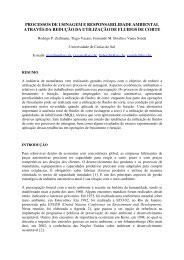
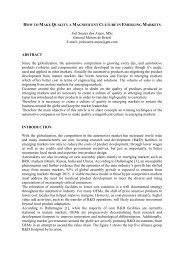




![Charles Correa Conconi, Mercedes-Benz [Modo de Compatibilidade]](https://img.yumpu.com/36264008/1/190x135/charles-correa-conconi-mercedes-benz-modo-de-compatibilidade.jpg?quality=85)
